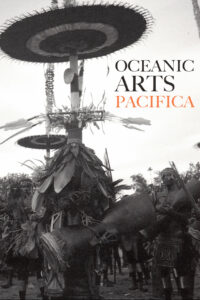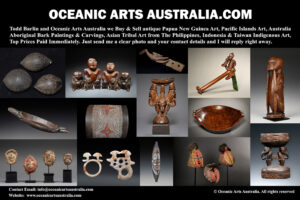A Superb Old New Guinea Massim Canoe Splash Board Milne Bay Province Papua New Guinea
| Collection No. | TB-192 |
|---|---|
| Size | Size 120cm x 110cm |
See more Canoe Ornaments from Canoe Ornaments Gallery
A Superb Old New Guinea Massim Canoe Splash Board Milne Bay Province Papua New Guinea
This is a superb Massim Canoe Splash Board from the Milne Bay Province of Papua New Guinea. Old & well-used this was once on the front of a large ocean-going canoe that was used for trading and was part of the complex Kula trading circle that built lifetime trading partners & commitments between a large group of small islands in the Milne Bay Province and sometimes further.
The main design elements are stylized birds on the upper section and below are four snakes, the designs are highlighted with white lime and remnants of old red paint. The Canoe Splash Board has considerable age and dates from the early 20th Century
Provenance: From the collection of the late David Baker (1943-2009 ) who was the president of The Oceanic Arts Society of Australia and was a great collector, expert & supporter of Oceanic Art & Cultures.
The Todd Barlin Collection of New Guinea Oceanic Art
It is called a “splashboard” because it closes the dugout hull of the canoe on both ends, deflecting waves and sea spray when sailing. Massim splashboards are cut from a single piece of wood – often the flat buttress root of a Ficus tree. The splashboard is incised in low relief and decorated on one side only. Visually, the splashboard has a central part with abstract motifs framed by two asymmetric volutes that spiral out and down to either side.
The archipelagos of the Massim region of southeast Papua New Guinea are renowned for their ancient and ongoing inter-island exchanges of ceremonial valuables and other objects. The most extensive of these exchanges is known as Kula and it is carried out in profusely decorated seagoing canoes carved from locally sourced trees. In the Kula, people travel to neighboring and distant islands to obtain one of two types of shell valuables: decorated armbands made of conus shells (known as mwali in Kilivila, one of the languages of the region); and necklaces made of red spondylus shells (known as bagi, veiguwa, or soulava in different local languages). Both types of valuables are exchanged by Kula partners from island to island following pre-established paths, with bagi necklaces traveling in clockwise motion while mwali arm shells are exchanged in anti-clockwise direction. Kula participants achieve fame and high status by exchanging these valuables, making the shells singularly coveted objects. Shells are indeed ranked in importance, with the highest ones having names and biographies, the unwritten stories of their journeys around the islands and those of the people who exchanged them in the past.
Splashboards serve the purpose of beautifying the canoe and captivating onlookers when they arrive in the islands where the Kula ceremonial exchange takes place. The aesthetic qualities of well-executed canoe woodcarvings are believed to enchant Kula partners, “softening” their minds and making them surrender their Kula valuable shells. Splashboards also encompass a series of symbols or emblems with apotropaic qualities. They are said to ward off so-called flying witches (yoyowa in Kilivila) that prey on shipwrecked crews, impregnating the canoes with lightness and swiftness so as to make them faster and more seaworthy. The stylized birds carved onto the board are identified with the sea eagle: just as the sea eagle dives down to take its prey, so do tokula (Kula exchange partners) plunge upon Kula valuables. Another significant symbol found in the splashboard is the weku. A hole at the center of the larger volute on the left of the splashboard, the weku stands for the voice of a bird that can be heard but cannot be seen, signifying the longing of the tokula for all the unattainable Kula shells that are known to circulate around the islands.
The human-like figure on top of the splashboard is known in Kilivila as tokwalu to the uninitiated, although it is properly called bwalai by master carvers and their initiated apprentices. The bwalai must be spelled with the right magic by the canoe owner prior to a journey, in which case it will assist the crew if the canoe capsizes by summoning a giant fish that will take the sailors safely ashore. But if the magic used is not correct or if the canoe owner forgets to cast the spell, the bwalai will turn into a shark or a sea monster in the event of a shipwreck and devour the crew. Bwalai are often represented either as gender-neutral individuals or as a male and female couple to signify the un-gendered qualities of spirit beings in the Massim.
Canoe splashboards are carved throughout the Massim in distinctive regional styles. They are material repositories of esoteric cognition that incorporate key elements of an otherwise-oral, immaterial system of knowledge. Canoe and splashboard master carvers are initiated into a highly specialized and ritualized apprenticeship at a very early age. The apprenticeship lasts many years and includes learning magic spells and incantations, imbibing substances, as well as adhering to a very rigorous system of taboos that need to be observed in order to carve beautiful and efficacious splashboards (the two qualities being synonymous in Massim culture). Traditional master carvers are not allowed to do preparatory drawing on the wooden board they are to carve but need to incise the piece directly, using small pocket knives and repurposed pieces of iron. Canoe carvers are highly regarded within their communities, bringing together the embedded cognition of their manual skills, a sense of artistry and a deep knowledge of their own culture.
Splashboards are customarily painted white, red and black. In the past, natural pigments would have been used: charred coconut husks mixed with water for black, a seed known as malaka in the Trobriand Islands for red, and chalk sourced in coastal areas, or the lime obtained from burning coral, for white. These are the same colors used in facial decorations in many islands in the Massim, establishing a parallel between people and the canoe, the splashboard being sometimes considered the “face of the canoe.” This splashboard is fully discolored and appears damaged as a result of water erosion.
Master carvers need to keep the right proportions between all the canoe parts, including the size of the decorated boards relative to the rest of the vessel. During their apprenticeship, carvers practice by making miniature splashboards. Part of their training consists in increasing the size of these carved splashboards once they master the technique and skills necessary to do so, until they scale up to reach the size required for a seagoing Kula canoe.
INQUIRE HERE
To see many more rare items and the finest masterpieces, please make an appointment with us to visit the gallery.
For all inquiries, please contact us.









